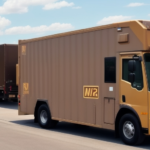Understanding UPS Shipping and Handling Rates
As a business owner, it is crucial to understand the various factors that determine UPS shipping and handling rates. UPS is one of the most popular shipping and logistics companies worldwide, providing businesses with reliable shipping services. However, the cost of shipping and handling can be a significant concern for businesses of all sizes.
How UPS Shipping and Handling Rates are Determined
UPS shipping and handling rates are determined by several factors, including:
- Package Size and Weight: Larger and heavier packages incur higher shipping costs.
- Destination: The farther the package must travel, the more expensive the shipping becomes.
- Shipping Method: Options such as UPS Ground or UPS Express impact the cost.
- Delivery Time: Faster delivery times typically result in higher costs.
Additionally, UPS offers optional services that can affect the overall cost, including:
- Signature Confirmation: Ensures that the package is received by the intended recipient.
- Insurance: Protects against loss or damage during transit.
- Special Handling: Required for fragile or hazardous materials.
Seasonal demand also plays a role. During peak holiday seasons like Christmas or Valentine's Day, shipping rates may increase due to high demand. Planning ahead and budgeting for these potential rate increases is essential.
Key Factors That Affect UPS Shipping and Handling Rates
Understanding the key factors that influence UPS shipping and handling rates can help businesses optimize their shipping strategies and reduce costs:
- Package Weight and Size: Accurately measuring and weighing packages can prevent unexpected fees.
- Delivery Location: International shipments generally cost more than domestic ones.
- Delivery Time: Selecting the appropriate delivery timeline can balance cost and speed.
- Shipping Method: Choosing between UPS Ground, Express, or Freight based on urgency and budget.
- Item Type: Shipping hazardous or fragile items may require special packaging and handling, increasing costs.
- Distance: Longer distances typically result in higher shipping costs due to increased fuel and handling expenses.
By considering these factors, businesses can select the most cost-effective shipping options tailored to their specific needs.
Tips for Negotiating Better UPS Shipping and Handling Rates
Negotiating better shipping and handling rates with UPS can significantly reduce expenses for businesses. Here are some strategies:
- Leverage Package Volume: Higher shipping volumes can provide leverage for negotiating discounts.
- Bundle Shipments: Consolidating multiple packages into a single shipment can lower costs.
- Request Loyalty Discounts: Frequent shippers may qualify for loyalty or repeat customer discounts.
- Compare Competitor Rates: Researching rates from other carriers ensures you’re getting the best deal.
- Optimize Shipping Practices: Streamlining packaging and shipping processes can identify areas for cost reduction.
By implementing these strategies, businesses can negotiate more favorable rates and enhance their shipping efficiency.
Common Mistakes to Avoid When Using UPS Shipping and Handling Services
To ensure a smooth shipping process with UPS, business owners should avoid the following common mistakes:
- Inaccurate Weight and Measurements: Incorrectly weighing or measuring packages can lead to unexpected costs or delivery delays.
- Poor Packaging: Inadequate packaging can result in damage during transit, increasing return rates and costs.
- Incorrect Shipping Address: Double-checking addresses is essential to prevent misdeliveries or returns.
- Neglecting Tracking: Utilizing UPS tracking services allows businesses to monitor shipments and address issues promptly.
- Ignoring Insurance: Not insuring valuable or fragile items can lead to financial losses in case of damage or loss.
By avoiding these mistakes, businesses can enhance their shipping reliability and customer satisfaction.
How to Calculate UPS Shipping and Handling Costs for Your Business
Accurately calculating UPS shipping and handling costs is vital for budgeting and pricing strategies. Here’s how to do it:
- Use UPS Online Shipping Calculator: Enter package weight, dimensions, destination, and shipping method to obtain cost estimates.
- Consider Additional Services: Factor in costs for services like insurance, signature confirmation, and special handling.
- Compare with Other Carriers: Evaluate rates from other shipping carriers to ensure competitive pricing.
- Optimize Packaging: Reducing package size and weight can lower shipping costs.
By considering all these factors, businesses can accurately estimate their shipping expenses and make informed decisions.
Differences Between UPS Ground, Express, and Freight Shipping Services
UPS offers a variety of shipping services to meet different business needs:
- UPS Ground: The most affordable option for domestic shipments within the US, suitable for less urgent deliveries.
- UPS Express: A faster option for urgent deliveries, ensuring packages arrive quickly.
- UPS Freight: Designed for larger, heavier packages, providing reliable freight transportation.
Additionally, UPS offers specialized services such as UPS Worldwide Express for international shipments that require swift delivery. This service is ideal for businesses needing to ship time-sensitive goods overseas.
An essential consideration when choosing a UPS service is the level of tracking and visibility:
- UPS Ground and Express: Offer real-time tracking and delivery confirmation.
- UPS Freight: Provides detailed tracking throughout the entire shipping process, including pickup, transit, and delivery.
Enhanced tracking ensures that businesses can monitor their shipments closely, ensuring timely delivery to customers.
Benefits of Using UPS Shipping and Handling Services for Ecommerce Businesses
UPS provides numerous benefits tailored to ecommerce businesses:
- Easy Integration: Seamlessly integrates with online marketplaces, simplifying the shipping process.
- Reliable Tracking: Offers robust tracking capabilities, enhancing customer satisfaction with transparent delivery statuses.
- Efficient Returns Handling: Facilitates quick and easy return processes, improving the overall customer experience.
- Diverse Packaging Options: Ensures items are shipped securely, with specialized packaging for fragile or high-value items.
- Eco-Friendly Options: Provides sustainable packaging solutions for businesses aiming to reduce their environmental impact.
Utilizing UPS’s comprehensive shipping services helps ecommerce businesses meet customer expectations for fast, reliable delivery while maintaining operational efficiency.
How to Track Your UPS Shipment and Monitor Delivery Status
Tracking packages with UPS is straightforward and offers multiple options for monitoring delivery status:
- Online Tracking: Enter your tracking number on the UPS website to view shipment progress in real-time.
- Alerts: Sign up for text or email notifications to receive up-to-date information on your package’s status.
- Delivery Management: Request to hold your package at a UPS location or schedule a specific delivery date and time via the UPS website or mobile app.
- Insurance Options: Add insurance to safeguard against loss or damage during transit, providing peace of mind especially for valuable items.
Additionally, following UPS’s packaging guidelines ensures that your package is properly protected, reducing the risk of damage and ensuring a smooth delivery process.
Understanding the Various Fees Associated with UPS Shipping and Handling
UPS shipping and handling fees can encompass a range of charges. Understanding these fees helps businesses effectively plan and budget their shipping expenses:
- Fuel Surcharges: Additional costs related to fluctuating fuel prices.
- Customs Fees: Applicable to international shipments, covering import duties and taxes.
- Handling Fees: Charges for oversized or fragile packages requiring special handling.
- Service-Specific Fees: Different shipping options like ground, air, and international shipping come with their own set of fees.
UPS offers discounts for high-volume shippers and those utilizing their online shipping tools, which can significantly reduce overall shipping costs. Carefully evaluating your shipping needs and understanding the associated fees ensures that businesses choose the most cost-effective shipping options.
How to Save Money on UPS Shipping and Handling Costs
Businesses can implement several strategies to reduce UPS shipping and handling costs:
- Select the Right Shipping Method: Choose the most appropriate shipping option based on package size, weight, and delivery urgency.
- Negotiate Volume Discounts: Leverage high shipping volumes to obtain better rates.
- Accurate Packaging: Measure and weigh packages precisely to avoid unexpected fees or penalties.
- Explore Alternative Carriers: Compare rates with other shipping carriers to find more competitive pricing for specific shipments.
- Implement Shipping Software: Automate label printing and tracking to streamline the shipping process and reduce labor costs.
- Optimize Packaging: Use efficient packaging to minimize size and weight, lowering shipping costs.
By adopting these strategies, businesses can effectively manage and reduce their UPS shipping and handling expenses, enhancing overall profitability.
Comparison of UPS Shipping and Handling Rates with Other Carriers
Comparing UPS shipping and handling rates with other carriers is essential for businesses seeking the most cost-effective shipping solutions. Key considerations include:
- Pricing: Evaluate base rates, fuel surcharges, and additional fees across different carriers.
- Service Offerings: Compare the range of services, including express, ground, and international shipping options.
- Delivery Times: Assess the speed of delivery services to meet business and customer expectations.
- Reliability: Consider carrier reputation for on-time deliveries and package handling.
- Tracking Capabilities: Evaluate the robustness of tracking systems and customer notification options.
Conducting a thorough comparison allows businesses to select the carrier that best aligns with their shipping needs, budget, and service quality expectations.
Understanding the Role of Packaging in Calculating UPS Shipping Costs
Packaging significantly impacts UPS shipping and handling costs. Proper packaging ensures safety and compliance with UPS guidelines, which can influence overall shipping expenses:
- Material Quality: Use sturdy, high-quality materials to protect packages during transit.
- Size and Weight: Optimize package dimensions and weight to minimize costs.
- Compliance: Adhere to UPS packaging guidelines to avoid additional handling fees.
- Cushioning: Incorporate adequate padding for fragile items to prevent damage and potential insurance claims.
Investing in appropriate packaging not only safeguards shipments but also helps prevent unnecessary additional fees, contributing to more efficient shipping operations.
How to Properly Package Your Shipment for Safe Transportation with UPS
Proper packaging is essential to ensure safe transportation of your shipments with UPS. Follow these guidelines to prevent damage and additional costs:
- Use Sturdy Boxes: Select boxes that are strong enough to handle the weight and contents of your shipment.
- Securely Seal Packages: Use high-quality tape to seal all seams and openings, preventing accidental spillages or openings.
- Protect Fragile Items: Utilize cushioning materials like bubble wrap or packing peanuts to safeguard delicate items.
- Label Clearly: Ensure that all labels are legible and securely attached to prevent misrouting.
- Follow UPS Guidelines: Adhere to UPS’s specific packaging requirements for different types of shipments.
By following these packaging best practices, businesses can ensure that their shipments arrive safely and cost-effectively.
Exploring the Different Options for International Shipping with UPS
International shipping with UPS offers a variety of options tailored to different business needs and compliance requirements:
- UPS Worldwide Express: Fast delivery for international shipments, ideal for time-sensitive goods.
- UPS Standard to Canada: Cost-effective option for shipments to Canada with reliable delivery times.
- Customs Clearance Services: Ensures compliance with international regulations and smooth delivery across borders.
Each shipping option comes with different costs, delivery times, and customs procedures. Businesses should research and select the best option based on their specific needs, destination countries, and the nature of the goods being shipped. Proper selection and preparation for international shipping can enhance efficiency and customer satisfaction.
In conclusion, understanding UPS shipping and handling rates empowers businesses to plan expenses effectively, reduce shipping costs, and avoid common pitfalls. By utilizing the right packaging, negotiating volume discounts, and accurately tracking shipments, businesses can manage their shipping operations more efficiently and enhance their overall profitability.






















